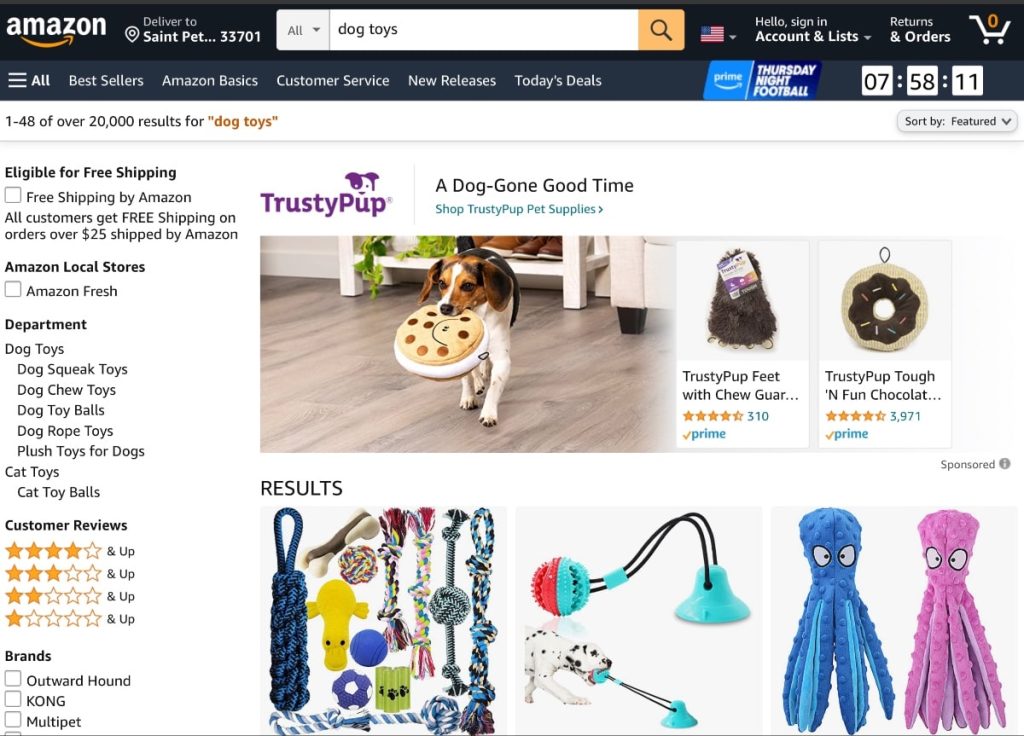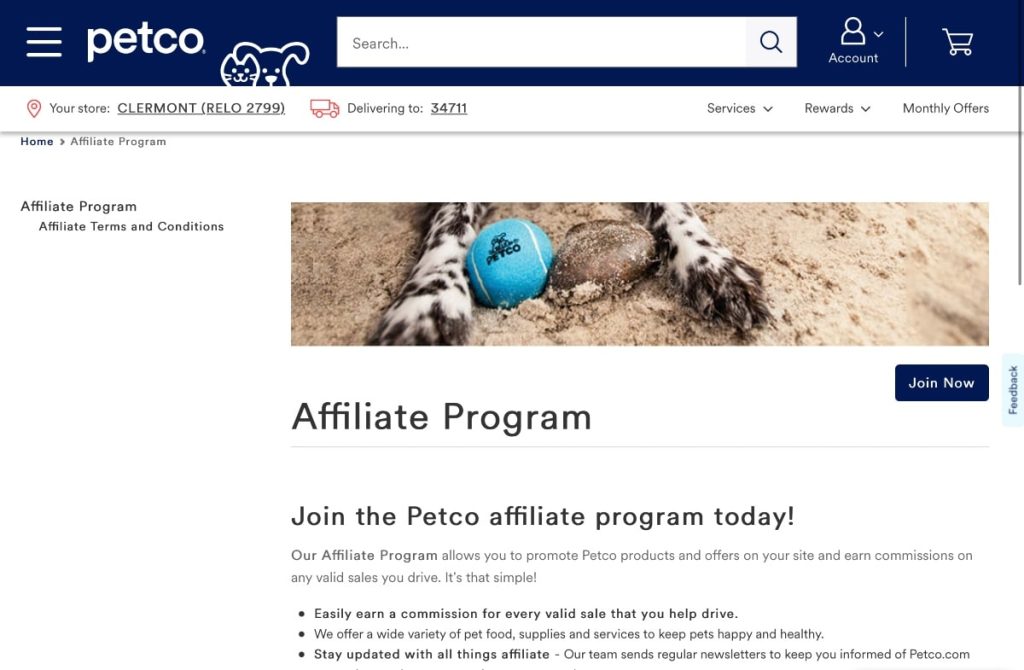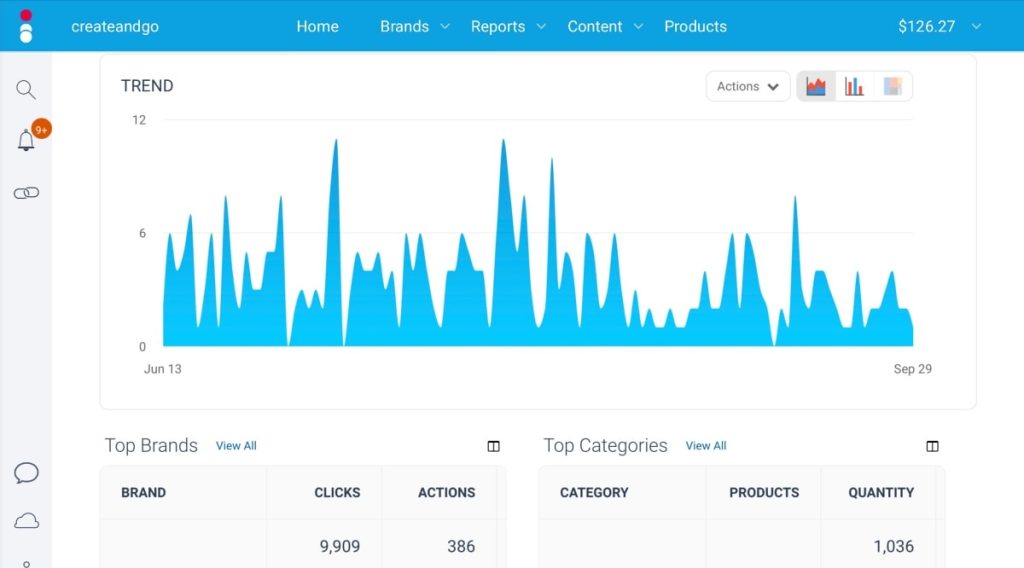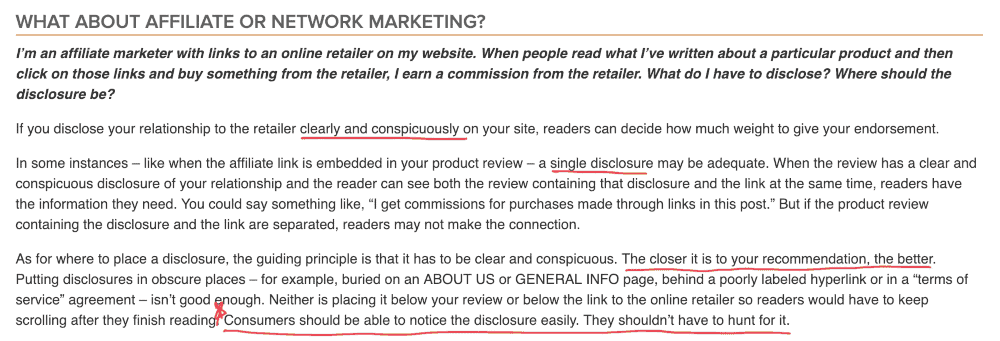Consider this your spark note guide to affiliate marketing for beginners. This is a pretty vast topic because there are a lot of ways that you can make money with affiliate marketing as a blogger.
If you’re keen to explore how to sell other people’s products and services to generate revenue for your blog — enough to even quit your day job, this is the post for you.
Affiliate Marketing Defined
At its core, affiliate marketing is a type of performance-based advertising. You might not have heard it defined in that way before, but that’s really what it is.
Businesses reward affiliates (individuals or organizations who promote their products or services) for each customer they bring in.
The most common way to do this is through a commission, which is a percentage of the total sale amount that the affiliate earns (or a set flat fee).
Many bloggers and website owners use affiliate marketing to monetize their content.
For example, if you have a blog about fashion, you could sign up for affiliate programs with clothing retailers and receive a commission whenever someone clicks on one of your links and makes a purchase.
Affiliate marketing can be a great way to monetize your blog if you want to generate passive income and already have an online presence.
BUT – even if you don’t have an online presence yet, you can start building one and earning as you grow.
It will take a lot longer to get to the point where your income is passive, but it’s 100% worth the effort that you put into it.
How to Do Affiliate Marketing
Affiliate marketing works by connecting businesses with affiliates who are willing to promote their products or services.
The business provides the affiliate with a uniquely tracked link to their website, and the affiliate then promotes this link on their site or through social media.
When a user clicks on the affiliate’s link and makes a purchase, the affiliate earns a commission.
Simple right?
There Are Usually 4 Parties Involved in Affiliate Marketing
This is how affiliate marketing is commonly set up — usually, but not always.
1. The Advertiser (Merchant/Brand)
The advertiser is the business that owns the product or service being promoted.
This will typically be the company, individual, or organization that wants to increase sales of their product or service.
Merchants usually have an affiliate program manager (APM) responsible for recruiting affiliates and maintaining relationships with them.
2. The Network
The network is the middleman between the advertiser and the affiliate.
Networks provide merchants with a way to find affiliates, and they also provide affiliates with a way to find offers to promote.

Networks are often responsible for tracking clicks, sales, and affiliates’ payouts.
A single network can have thousands of affiliates, and dozens of networks operate worldwide.
Some networks are generalists, while others are focused on a particular niche (such as travel or pets).
Joining a network is usually free, and they sometimes offer commissions to content creators that drive more sign-ups as advertisers or affiliates.
For example, ShareASale is an affiliate network that pays content creators who recruit other content creators to be an affiliate for them.

Other examples of affiliate networks include:
3. The Affiliate (Content Creator/You)
The affiliate is the individual content creator or organization that promotes the merchant’s products or services in exchange for a commission.
It’s their job to drive traffic to the merchant’s website through their website and social media platforms.
Effectively, they convince potential customers of the product’s or service’s values and benefits and then send them to the merchant’s site to make a purchase.
When customers make a purchase, the affiliate earns a commission.
The amount of the commission varies depending on the merchant and the terms of their affiliate program. Some merchants offer a flat rate, while others use a tiered commission structure or even a recurring commission.
For example, there are some brands that will offer an affiliate a 10% commission on all purchases, but after you reach a revenue threshold of $500 let’s say, your commission increases to 15%.
Many subscription-based services will pay you a flat fee or percentage of the sale every time the subscription renews (monthly or yearly).
You can see how this kind of earnings can quickly stack up and become more passive — compared to constantly driving new sales.
For example, ClickFunnels pays its affiliates not just a one-time fee, but an ongoing commission for every month the customer pays for the service.
This leads us to the last piece of the proverbial puzzle…
4. The Customer (Audience/Purchaser)
The customer is the final piece in the affiliate marketing game. They are the ones who see the affiliate’s promotion and click on the link.
They are then taken to the merchant’s site, where they may or may not make a purchase. If they do make a purchase, the affiliate earns a commission.
As you can see, they are the most important part of the equation. Without them, no sales and no commissions.
The customer is not obligated to purchase anything and is not charged anything extra for clicking on the affiliate’s link.
Note: Not all affiliate programs are run through a network.
Sometimes, the advertiser/brand/merchant handles their affiliate program in-house.
For example, here at Create and Go, we sell courses and manage our affiliate program for in-house through the software we use to sell our courses — Kajabi.
While we’re using a third party to host the courses and distribute the payments to our affiliates, we don’t have a network promoting the affiliate program on our behalf.
We choose to do it this way because Teachable offers affiliate management as part of their Pro plan and we prefer to approve affiliates ourselves through our own affiliate policy.
The great thing for content creators working directly with advertisers is that they generally enjoy a higher commission because there isn’t a middleman taking an additional cut.
The Step-By-Step Guide to Affiliate Marketing for Beginners (and Bloggers)
Continuing our “Affiliate Marketing for Dummies” guide, let’s move on to how you can get started with affiliate marketing and become an affiliate marketer yourself!
1. Choose a niche [with intention].
You’re probably thinking, ”Wait, I already have a blog. So obviously I already have a niche.”
Yes, I’m sure that is true. But it’s not just about choosing A niche — it’s also about narrowing down that niche enough to make sure you’re situated properly for affiliate marketing success.
You need a target market of people who are more likely to buy if you want to have real success with affiliate marketing.
Throwing everything up at the wall and seeing what sticks isn’t the right approach here. Trust me, I’ve tried.
The first blog that the Create and Go team started was a health blog and that’s all it was at the time. That broad topic encompassed general health, fitness, dieting, recipes, and more.
The market was not-so-targeted and they tried all kinds of affiliate programs and products, but it was like shooting in the dark.
Now, after a lot of trial and error, they narrowed down their niche to ”fast weight loss for women.”
From there, the affiliate marketing strategy became simpler:
- Best weight loss books for women
- Best weight loss programs for women
- Best weight loss tools for women
- Etc. Etc. Etc.
As a blogger, you’re probably already focused on a particular topic, such as personal finance, fashion, or travel.
But one thing we see over and over again is that bloggers haven’t narrowed down their niche enough.
You focus on too many broader topics that don’t speak to a specific group of people. It’s harder to build relationships and trust with people when it’s written for the masses.
Huge media publishers are the only ones who can get away with this — and that’s mostly because they have teams of writers and SEO experts behind them.
Now, you shouldn’t narrow down your niche too much. It should be just specific enough that you can build an audience of dedicated people around it.
This will help you target your audience more effectively and find the right products or services to promote.
Additionally, you will also rank higher in search engines for more specific keywords.
Here’s a quick run-down of how to choose a niche and narrow it down:
- Brainstorm a list of potential ideas.
- Narrow it down to the one you are most passionate about or interested in.
- Create a customer avatar.
Create a Customer Avatar
Creating a customer avatar will help you create content with less effort because instead of speaking to the masses, you are speaking to that one ideal customer.
Here’s an example customer avatar:
- Name: Debra the Dog Trainer
- Pain points: Debra’s biggest concern is training her clients’ dogs with as little hassle as possible.
She wants her clients’ dogs to learn to listen to commands and be obedient.
Things Debra needs to solve her pain points:
- Training treats
- Obstacle course materials
- Barriers
- Portable mats
- Pet gates/playpens
- Leashes
- Target sticks
- Treat bag/fanny pack to carry the treats
- Toys
- Water bowls
Each of these items could be an affiliate product. And the easiest place to become an affiliate is Amazon Associates.

Amazon is one of the easiest places to start, but you also need a significant amount of traffic to earn any real income from this — or to sell much higher-priced products.
That health blog I told you about earlier? It earned as much as $1,000/month through Amazon Associates, but that was with 500,000 monthly views, which is a LOT.
To give you a benchmark to compare it to, it was earning $30,000/month through other methods of monetization.
Still, Amazon Associates is one of the lowest barriers to entry and a great starting point to get your feet wet. More on that in a moment though.
2. Make sure your website is set up [properly].
If you’re interested in affiliate marketing, I’m going to assume that you already have a website and some content.
But it’s not enough to just have A website. Make sure that you have a self-hosted (aka not free) website for this.
A self-hosted WordPress website will allow you to install plugins and themes and have more control over the design and functionality of your website.
All of this will translate into higher affiliate earnings commissions.
Here are the quick steps for this process:
- Start a self-hosted blog or website (step-by-step guide)
- Choose a customizable theme
- Write a few blog posts
Now, let’s focus more on the most important part — your content.
3. Make a list of the various products you want to promote.
This is just a simple list of the potential products you could or wish to promote. There are a few ways to do this.
- You can visit the websites of the companies you want to promote and looking for their affiliate program.
- You can search online for ”your niche + popular affiliate programs” (or products).
- Join an affiliate network and search for products in your niche.
I would recommend starting out with option 1 first. There is a little more intention behind this one if you can generate your own ideas.

Many companies will have an affiliate page containing all the information you need to start. It’s often found somewhere in the footer menu at the bottom of their website.
This will include the terms and conditions of their affiliate program and links to their banners and other marketing materials.
Once you’ve exhausted option 1, you can move on to options 2 and 3 to look for other ideas on products, services, and programs to promote.

4. Do some research and due diligence on the product.
It’s important to make sure that the product or service is worth selling before you start applying.
There are a lot of bad affiliate products out there and there is no easier way to break trust with your audience than to recommend a sh*t product.
You’d be surprised at how many products or services have really great sales pages but the product itself is terrible.
On that first health blog, we once recommended a really highly rated diabetes product to our audience. But those ratings must have been biased or outdated because it was only after the emails started flooding in about how bad the product was that we realized we had messed up.
In truth, we should have bought this particular product first before recommending it to our audience. Sometimes, this is necessary to make an honest recommendation.
Once you have a large enough audience, you will also probably get offers for free products in exchange for reviews and affiliate content.
This is okay but you should only recommend the products that you truly believe in — not the ones that are free or with the highest payout. More on that next.
5. Select the products you plan to promote carefully.
I’ll give you a little tip here that I learned from experience.
The more you believe and truly stand behind a product, the easier it will be to sell it.
Your recommendation will be honest and come from real experience. That’s infectious and it gives people a reason to buy and also buy FROM YOU.
Along the way, you will find that some affiliate products or services have much higher payouts than others. It will be tempting to promote these because of the potential for higher earnings.
But it doesn’t mean that the product is great. It just means that the affiliate program knows how to be competitive.
We’ve found that building genuine relationships and partnerships with brands has been the quickest, best, and most honest way to earn six figures with affiliate marketing.

In addition, focusing on these partnerships and becoming a great affiliate for these brands has helped us get discounts and bonuses for our audience, which incentivizes people to use our affiliate links when purchasing.
One last thing I want to say here is to make sure to read through the terms and conditions carefully before signing up for an affiliate program.
Some companies restrict how you can promote, how much you can earn, and more.
The most obvious example here is Amazon Associates. You can’t promote Amazon products via email or other pages that require access (eBooks, courses, membership programs).
You also must make 3 Amazon sales within the first 90 days or they will remove you from the program and you have to reapply and get new links.
So this would tell you immediately that if you don’t have traffic to your website yet, you should wait to sign up until you do and can make sure you can get those sales.
6. Start signing up for affiliate programs.
You will need a few pieces of important information when you sign up for most affiliate programs.
This includes, but may not be limited to:
- Banking information for direct deposits of your sales commissions
- Social security number (most affiliate programs need you to complete a tax form to keep things legal and keep the tax man happy)
- Link to your website
- Most affiliate programs will require you already have a website online
- Plan for promotion – Some merchants require you to explain how you will promote their products i.e.
- Will you write reviews?
- Include hyperlinks within articles?
- Will you add links to email newsletters?
- What about social media?
The better your plan for promotion, the more seriously merchants and/or affiliate networks will take your application.
And if you’re just starting out, keep in mind that you might not qualify for every program you sign up for.
Similar to how Mediavine requires 50,000 unique sessions monthly, the larger affiliate programs may require a certain number of page views or a certain number of people on your email list as a qualifier for being accepted in their program.
These barriers are usually limited to programs that have larger payouts. But some affiliate companies also just don’t want to take the time to review applications and onboard people that don’t even have an audience yet.
Some policies state that you must be a customer to promote a product.
We have a similar requirement at Create and Go because we feel that it’s important for someone to have taken our course to effectively promote it and speak for their experience.
We only make exceptions to this for people with much larger audiences. So don’t forget that you need to think about what’s in it for them when you’re applying!
7. Once accepted, get your affiliate links and start promoting!
Now, before you go and slap a bunch of links all over your website… Let’s talk about the better way to be a successful affiliate marketer.
The very first step that you should take is to download the Pretty Links plugin (free version) so that you can save all of your affiliate links in one place and make them look ”prettier.

Not only does this LOOK a lot better, but it’s also a hell of a lot easier to remember, which helps when you are creating content or sharing that link with others.
Once you get your links sorted, it’s time to add them to your content.
A word of caution here… Only do this where it makes sense. Don’t force it or oversell.
When you force an affiliate link, your audience can tell and it may make them feel like you’re only trying to sell them something. A quick way to break trust before it’s built.
Here are a few ideas on how you can start promoting your affiliate links:
- Start with existing content and add affiliate links where it makes sense.
- Create banner ads on your website for affiliate products. These can go on your sidebar, be added strategically throughout your copy, or be added to your header/footer
- Create a resources page for your website that lists all of your go-to products for whatever your blog is about.
- Create sales (or product) focused content.
The last one is one of the most effective ways to generate affiliate sales without being overly salesly.
Here are a few examples of our product-focused content (with affiliate links):
Just remember this VERY important point when you are creating this kind of content:
Always remember what’s in it for them and make sure to add a lot of value to the content.
People don’t just want to know WHAT is the best — they want to know WHY it’s the best and sometimes more importantly, why YOU think it’s the best.
No one wants to be bombarded with sales pitches or ads, so make sure to be honest and tasteful about it.
8. Get creative with your promotion methods.
There may be methods of promotion you haven’t yet thought of.
For example, let’s say you have a yoga blog and you’re selling a yoga affiliate product — a yoga program.
Your promotion strategy could be to create a pop-up Facebook group and offer to take the class with your audience.
The group not only gives you a way to interact with your audience and learn more about them, but it also helps you build trust with your most loyal and engaged people.
It’s also like a form of paid research if you’re thinking of developing your own yoga program at some point.
The benefits don’t stop there. A community group is also a way to keep people more accountable, which means more success and more testimonials, which means more affiliate sales in the future.
Now, that one is pretty involved and not everyone will have the time or inclination to do that. Another (much easier and more passive) method is to offer bonuses or giveaways.*
This one comes with a big asterisk* because not all affiliate companies allow this. It’s important to read through their terms to make sure you aren’t violating them.
Some people do giveaways on social media and host other types of contests.
One of our favorite ways is to offer bonuses or other discounts.
You can create a bonus PDF in Canva to send to people who purchase the affiliate product. You’ll have to ask them to forward you their receipt because you don’t usually get access to affiliate customer info.
We have successfully done this with a few affiliate products in the past, but not all companies allow it.
In order to get discounts for your audience, you usually need to prove that you’re a top-earning affiliate and the relationship is worth investing in for the affiliate partner.
We have worked out deals with Bluehost, Kit, Tailwind, Divi, and other companies after achieving a high amount of sales.
Like getting a free month on Teachable’s Pro plan:

This is definitely the final frontier after you’ve grown your audience significantly, which we’ll talk about next.
9. Build and grow your audience.
At last, we’ve finally arrived at the traffic part of the equation. The above strategies are only successful when you have an audience to promote your content (and affiliate products).
Once you have your links and content in place, learning how to drive more traffic to your website is how you can start to scale your affiliate income.
Here are a few different routes that you can take to accomplish this:
- Keyword research and looking for the low-hanging fruit that will draw in more organic visitors
- Considering an ad strategy to run ads and draw in paid traffic (expensive route)
- Developing better content that helps your audience solve their biggest pain points
- Creating better graphics that you can use on your website, in your email newsletters, and even in social media promotions (try Canva templates)
- Diversifying your content across platforms like YouTube, podcasts, Pinterest, Google web stories, and more
- Guest posting to get your name out there to more people and establish yourself as an expert in your niche
SEO is what we focus on at Create and Go. Make sure that you at least have the basics covered.
10. Build upon your strategies.
As your page views increase and your social media followers grow, start going after the bigger fish.
Look for those larger payouts and the bigger affiliate programs. Ask for discounts and form partnerships.
We’ve been able to get custom landing pages and exclusive promotions by working with companies like Bluehost and Teachable. We’ve been affiliates for many of our biggest partners for years now and have even met members of their team in person at conferences and other events.
It takes time and effort to build these partnerships, but they are worth it and can pay you for years to come.
And at some point, you might start making enough money to begin outsourcing things like:
- Content creation (i.e. writing your blog posts and designing your graphics)
- Signing up for affiliate programs
- Posting to social media
- Editing your YouTube videos
- Writing/curating your newsletters
- Getting guest post and guest podcast opportunities, and more
We’re hoping to help you go from reading a post about affiliate marketing for dummies to being a six-figure affiliate marketing boss!
Lastly, let’s talk about a few things NOT to do along this journey to success.
Biggest Mistakes of Affiliate Marketing
Okay, we’ve covered a lot related to how to make money with affiliate marketing, but I think it’s also important that we discuss the WRONG ways to do this.
Because these are the things that many people are going to try first — without having read this affiliate marketing for beginners guide.
Failure IS an option, folks. We failed many times in the first few months of trying to monetize with affiliate marketing — thankfully for you because now we can share.
Here are eight of the most common mistakes that people make when they’re first starting out in affiliate marketing:
1. Not Defining Your Target Audience
We already touched on this one above relating to choosing your niche and identifying your target customers. It’s really important.
If you can narrow in on who they are and what exactly they want, you’ll be able to put the right products in front of the right people. Sales Marketing 101.
Sometimes you don’t always know this right away and it can take some time to figure out, and that’s okay.
Try asking your audience questions in your content. Listen to their responses.
2. Not Researching Your Competition
Another mistake that people make is not taking the time to research the competition.
If you want to know how to become an affiliate marketer that makes just as much or more than other blogs in your niche, start researching what they’re doing.
I’m not saying that you should copy the content itself, but it’s perfectly okay to replicate the strategies behind the content.
Who are your biggest competitors? What are they doing well? Can you do better?
Do some research into what kind of content they are creating and how and where they are recommending affiliate products and services.
3. Not Creating Compelling Enough Content
Your affiliate marketing strategy is only as strong as the content that carries and delivers it.
Here are a few tips for creating better content:
- Always deliver tons of value before asking for a sale.
- Make sure your content is long enough (and thorough enough).
- Your links should be visible (don’t wait until the end of the content).
- Don’t forget to educate your audience on the problem (as opposed to just telling them how to fix it).
To make money as an affiliate marketer you must create content that draws people in and makes them want to stick around for more.
4. Not Building an Email List
Email marketing is one of the best ways to scale your affiliate marketing income.
Every person in your audience is a potential subscriber and every subscriber is a potential customer.
Building an email list gives you a space to engage with your audience, build more trust, and market products better.
It will also provide you with a means to reach people again when you have an affiliate promotion or new piece of content again.
5. Not Promoting Regularly (Or Enough)
You researched how to make money with affiliate marketing. You read this and other posts on affiliate marketing for dummies.
You’ve added the links where I’ve told you and yet the sales still aren’t coming in. Let’s give it another run-through and see if we can find some additional opportunities that you may have missed the first time.
The very first place that you should start is with your top content that is already getting views. Try to capitalize on that if you can.
After that, try any and all of these:
- Create review and comparison articles for popular products or services.
- Create videos and make sure to add the links to your descriptions (early on).
- Create problem-solving content with an affiliate product as the solution.
This is another form of sales or product-focused content that will help you educate and provide value before offering a great solution (towards the end).
Just remember not to sell too soon and to always focus on the value first.
6. Not Tracking Your Results
You might be surprised by this one, but if you want to make money as an affiliate marketer and actually know how and when to scale it — you need to start tracking your results.
I know it can be disheartening to check your affiliate dashboard on the daily and see low numbers, but when those sales do come through, pay attention to where they came from.
Was it that article that you wrote? That email that you sent? That story or video that you shared?
Some affiliate programs that are hosted on hugely successful platforms, like ImpactRadius, provide tools to help you track the different links that you share.

Take advantage of this and pay attention to what’s working and what’s not.
When something is working, take a deeper dive into WHY it worked so that you can do more of that thing (and less of what isn’t working).
7. Not Disclosing Your Affiliation/Partnerships
One thing I haven’t mentioned yet is the legal requirement for affiliate disclosures.
You must disclose your relationship with affiliated companies and tell your audience up front that your content may contain affiliate links and you may receive a commission from them.
These laws and guidelines are set by the Federal Trade Commission, or FTC for short, and they are in place to protect consumers and let them know that the opinions may be biased due to financial compensation.

Additional rules and guidelines can also be set by the affiliate company, so you need to make sure you read over all of their terms and understand their requirements too.
For example, Amazon Associates requires disclosure on every single page that mentions their company specifically. Most people choose to place this in the footer of their website.
Bottom line: Follow the rules, disclose your relationship appropriately, and don’t ever try to hide your affiliate links or relationship.
8. Link Spamming
I’ve touched on this one a bit already when I mentioned being tasteful with your link placement — aka don’t link vomit on your page.
If you link too often or too many products, people will get link blindness and not want to click on anything or believe you’re just trying to sell them something.
For example, if you have a recipe blog, don’t link white rice on Amazon. Ain’t nobody gonna order that on Amazon. It’s like $0.75 at the grocery.
Now, if you’re recommended some super secret crazy brand of rice that costs $20 and is imported from Indonesia — maybe that’s a different story.
In many cases, it’s better to promote fewer, higher-quality products than the shotgun approach of too many little, insignificant products.
This is a strategy that has served us very well on this website.
9. Not Diversifying Your Income
This is not entirely related to how to make money with affiliate marketing, but it’s important to your overall monetization strategy.
Affiliate marketing can be a great source of income — it’s earned us between $10,000 – $50,000/month on this website.
Some months are better than others and some years are better than others. The important thing is that it’s not the only way that we monetize at Create and Go.
Additionally, we belong to several really great affiliate programs that make up that income. We diversify our affiliate marketing strategy as well.
If you rely on Amazon Associates for the bulk of your income, you’re going to be screwed when they slash prices (which they have done in the past).
Diversify your entire monetization strategy, including your affiliate marketing strategies.
10. Giving Up Too Soon
One of the biggest mistakes that people make when attempting to make money as an affiliate marketer is giving up too soon.
Just because your first few campaigns don’t produce amazing results doesn’t mean that you should give up on affiliate marketing altogether.
If you’re willing to put in the time and effort, you can be successful — because the real money comes from playing the long game.
A lot of affiliate marketing for beginners guides hype up large sales numbers, but they don’t always share the sh*tshow of failures that they had to get there.
That first health blog I mentioned earlier? It took months of trial and error to make any money with affiliate marketing.
And to be honest? It was never a large portion of the income earned from that website. It just didn’t work as well as expected. But from that came a lot of lessons learned and strategies that worked a lot better at Create and Go.
Create a strategy. Track your results. Develop new strategies. Scale what works. If at first you don’t succeed, try again (and again and again and again). Something WILL work eventually.
Affiliate Marketing Best Practices: Do’s and Don’ts
To close out this guide to affiliate marketing for beginners, I will leave you with some best practices as you go about your blogging journey:
DO pay attention to current trends.
Trends change quickly, and you can sell a lot more through your blog by staying ahead of the curve. Getting in early on can also be a good strategy to get SEO traffic.
DON’T Keyword stuff.
Affiliate marketing for dummies 101: If you’re trying to get your affiliate content to rank, don’t keyword stuff. Google will smell your desperation a mile away.
DO create evergreen content.
Evergreen content is the type of content that remains relevant and useful over a long period. This is in contrast to timely content, which is only relevant for a short time and then quickly becomes outdated.
DON’T violate the terms of service.
They will catch you. They pay attention, especially to affiliates generating sales quickly. You’ll get kicked out if you do anything that violates the terms of service and your money will be forfeited.
Do use attractive visuals or other resources.

Sometimes you can get images, videos, or other helpful resources to use in promotion. Ask your affiliate company if you don’t see any in your dashboard.
DON’T use visuals without permission.
Some companies have rules on how their logos or images can be used. Amazon specifically has a lot of rules around this.
DO use effective CTAs.
A call-to-action (CTA) is a statement that encourages your readers to take a specific action, such as clicking on your affiliate link. CTAs should be attention-grabbing and relevant to the article to stand out and encourage people to click on them.
Make sure to include these at the end of your content.
DON’T be shady or use deceptive practices.
This one should be obvious, but there is a lot of spammy content out there with people just looking for easy clicks. This doesn’t work.
You can’t trick anyone into buying. You have to convince them to buy through education, trust, and honesty.
DO start building a solid affiliate marketing strategy today!
Affiliate marketing is a great way to monetize your blog and one of the absolute best places to start.
It takes a lot less time and is easier to set up than creating your own products.
I hope that you found this post on how to become an affiliate marketer helpful. If you have anything else to add or have any questions for us, please leave a comment below!